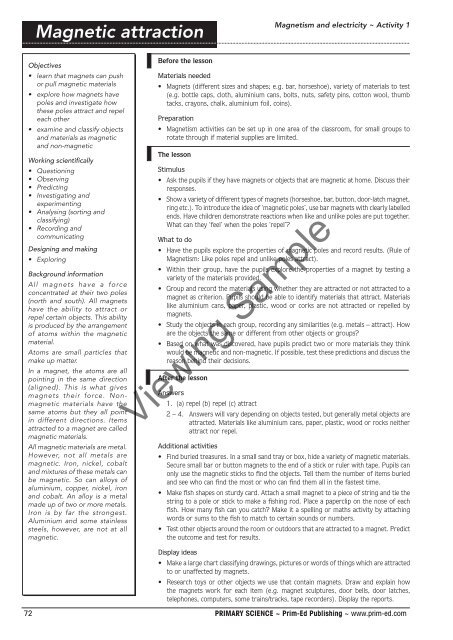PR-0553UK Primary Science - Book 3
Create successful ePaper yourself
Turn your PDF publications into a flip-book with our unique Google optimized e-Paper software.
Magnetic attraction<br />
Magnetism and electricity ~ Activity 1<br />
Objectives<br />
• learn that magnets can push<br />
or pull magnetic materials<br />
• explore how magnets have<br />
poles and investigate how<br />
these poles attract and repel<br />
each other<br />
• examine and classify objects<br />
and materials as magnetic<br />
and non-magnetic<br />
Working scientifically<br />
• Questioning<br />
• Observing<br />
• Predicting<br />
• Investigating and<br />
experimenting<br />
• Analysing (sorting and<br />
classifying)<br />
• Recording and<br />
communicating<br />
Designing and making<br />
• Exploring<br />
Background information<br />
All magnets have a force<br />
concentrated at their two poles<br />
(north and south). All magnets<br />
have the ability to attract or<br />
repel certain objects. This ability<br />
is produced by the arrangement<br />
of atoms within the magnetic<br />
material.<br />
Atoms are small particles that<br />
make up matter.<br />
In a magnet, the atoms are all<br />
pointing in the same direction<br />
(aligned). This is what gives<br />
magnets their force. Nonmagnetic<br />
materials have the<br />
same atoms but they all point<br />
in different directions. Items<br />
attracted to a magnet are called<br />
magnetic materials.<br />
All magnetic materials are metal.<br />
However, not all metals are<br />
magnetic. Iron, nickel, cobalt<br />
and mixtures of these metals can<br />
be magnetic. So can alloys of<br />
aluminium, copper, nickel, iron<br />
and cobalt. An alloy is a metal<br />
made up of two or more metals.<br />
Iron is by far the strongest.<br />
Aluminium and some stainless<br />
steels, however, are not at all<br />
magnetic.<br />
Before the lesson<br />
Materials needed<br />
• Magnets (different sizes and shapes; e.g. bar, horseshoe), variety of materials to test<br />
(e.g. bottle caps, cloth, aluminium cans, bolts, nuts, safety pins, cotton wool, thumb<br />
tacks, crayons, chalk, aluminium foil, coins).<br />
Preparation<br />
• Magnetism activities can be set up in one area of the classroom, for small groups to<br />
rotate through if material supplies are limited.<br />
The lesson<br />
Stimulus<br />
• Ask the pupils if they have magnets or objects that are magnetic at home. Discuss their<br />
responses.<br />
• Show a variety of different types of magnets (horseshoe, bar, button, door-latch magnet,<br />
ring etc.). To introduce the idea of ‘magnetic poles’, use bar magnets with clearly labelled<br />
ends. Have children demonstrate reactions when like and unlike poles are put together.<br />
What can they ‘feel’ when the poles ‘repel’?<br />
What to do<br />
• Have the pupils explore the properties of magnetic poles and record results. (Rule of<br />
Magnetism: Like poles repel and unlike poles attract).<br />
• Within their group, have the pupils explore the properties of a magnet by testing a<br />
variety of the materials provided.<br />
• Group and record the materials using whether they are attracted or not attracted to a<br />
magnet as criterion. Pupils should be able to identify materials that attract. Materials<br />
like aluminium cans, paper, plastic, wood or corks are not attracted or repelled by<br />
magnets.<br />
• Study the objects in each group, recording any similarities (e.g. metals – attract). How<br />
are the objects the same or different from other objects or groups?<br />
• Based on what was discovered, have pupils predict two or more materials they think<br />
would be magnetic and non-magnetic. If possible, test these predictions and discuss the<br />
reason behind their decisions.<br />
After the lesson<br />
Answers<br />
1. (a) repel (b) repel (c) attract<br />
2 – 4. Answers will vary depending on objects tested, but generally metal objects are<br />
attracted. Materials like aluminium cans, paper, plastic, wood or rocks neither<br />
attract nor repel.<br />
Viewing Sample<br />
Additional activities<br />
• Find buried treasures. In a small sand tray or box, hide a variety of magnetic materials.<br />
Secure small bar or button magnets to the end of a stick or ruler with tape. Pupils can<br />
only use the magnetic sticks to find the objects. Tell them the number of items buried<br />
and see who can find the most or who can find them all in the fastest time.<br />
• Make fish shapes on sturdy card. Attach a small magnet to a piece of string and tie the<br />
string to a pole or stick to make a fishing rod. Place a paperclip on the nose of each<br />
fish. How many fish can you catch? Make it a spelling or maths activity by attaching<br />
words or sums to the fish to match to certain sounds or numbers.<br />
• Test other objects around the room or outdoors that are attracted to a magnet. Predict<br />
the outcome and test for results.<br />
Display ideas<br />
• Make a large chart classifying drawings, pictures or words of things which are attracted<br />
to or unaffected by magnets.<br />
• Research toys or other objects we use that contain magnets. Draw and explain how<br />
the magnets work for each item (e.g. magnet sculptures, door bells, door latches,<br />
telephones, computers, some trains/tracks, tape recorders). Display the reports.<br />
72 <strong>PR</strong>IMARY SCIENCE ~ Prim-Ed Publishing ~ www.prim-ed.com


















